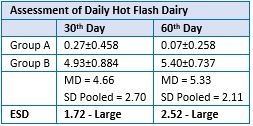A clinical study to evaluate the efficacy of Dahaprashamana Gana in the management of Vasomotor Symptoms in Perimenopause and Menopause
DOI:
https://doi.org/10.21760/jaims.7.10.1Keywords:
Vasomotor Symptoms, Rajonivrutti, Pittahara, Dahaprashamana, Vitamin E capsuleAbstract
Background: Menopause is a transitional phase marking the finale of the reproductive life of a woman. It’s associated with complex physical and psychological changes. The vasomotor symptoms are the hallmark of menopause, affecting 75% of women and among this 25% are severely affected and are the most common and long-lasting symptoms according to many studies. In Ayurvedic literature “Rajonivrutti” has very little references available. The age of Rajonivruthi is said to be around 50 years as per the classics and it is considered as a premonitory sign of Jara in women. The vasomotor symptoms like hot flushes, night sweats, irritability clearly indicate the involvement of dominant Pitta Dosha associated with Vata. Hence a drug that pacifies Pitta along with Vata, without disturbing Kapha will be ideal for treatment. Dahaprashamana Gana explained in Charaka Samhitha Sutrasthana, denotes a group of medicinal plants, which has been indicated as useful in removing Daha which is a direct manifestation of Pitta. Aim: To analyse the effect of Dahaprashamana Churna in the management of vasomotor symptoms in perimenopause and menopause. Method: A simple randomized open label controlled clinical study thirty subjects fulfilling the diagnostic criteria of Vasomotor symptoms were selected and randomly categorized to Group A and Group B by using lottery method. Result: Dahaprashamana Churna found to be effective in all subjective and objective parameters. Conclusion: Dahaprashamana Churna is more effective than Vitamin E in the management of Vasomotor symptoms in Perimenopause and Menopause
Downloads
References
Dutta D C. Textbook of Gynecology, 6th edition. New Delhi: Replica press; 2013.p.47
Agnivesha, Charaka Samhita of Acharya Charaka, Ram Karan Sharma and Bhagwan Dash. Sutrasthana. Ch.4, 2nd edition, Varanasi: Chaukhambha Sanskrit Series; 2007.p.98.
Narendra Malhotra, Pratab kumar, Jaideep Malhotra, Neharika Malhotra Bora, Parul Mittal. Jeffcoate’s Principles of Gynecology, 7th edition. New Delhi: Jaypee Brothers Medical;2008.
Agnivesha, Charaka Samhita of Acharya Charaka, Ram Karan Sharma and Bhagwan Dash. Sutra sthana. Ch.3, 2nd edition, Varanasi: Chaukhambha Sanskrit Series; 2007.p.94.
Barbara L. Hoffman, John O.schorge, Karen D.bradshaw, Lisa M.halvorson, Joseph I.schaffer, corton. In: et al. (eds.) Williams gynecology; 3rdedition, McGraw-Hill Publishers, reprint 2016 chpt.no.8,p.186.
Agnivesha, Charaka Samhita of Acharya Charaka, Ram Karan Sharma and Bhagwan Dash. Sutrasthana. Ch.26, 2nd edition, Varanasi: Chaukhambha Sanskrit Series; 2007.p.120
Agnivesha, Charaka Samhita of Acharya Charaka, Ram Karan Sharma and Bhagwan Dash. Sutrasthana. Ch.26, 2nd edition, Varanasi: Chaukhambha Sanskrit Series; 2007.p.132
Vruddha Vagbhatta, Ashtanga Sangraha with Hindi Commentary by Gupta K A. 1st ed. Varanasi: Krishnadas Academy; 2005.p.18















